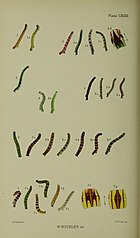| Eupithecia distinctaria | |
|---|---|

| |

| |
| Illustration depicting an unusually brown (Western) specimen | |
| Scientific classification | |
| Domain: | Eukaryota |
| Kingdom: | Animalia |
| Phylum: | Arthropoda |
| Class: | Insecta |
| Order: | Lepidoptera |
| Family: | Geometridae |
| Genus: | Eupithecia |
| Species: | E. distinctaria |
| Binomial name | |
| Eupithecia distinctaria Herrich-Schäffer, 1848 | |
| Synonyms | |
| |
Eupithecia distinctaria, the thyme pug, is a moth of the family Geometridae. It is found throughout Europe. It is also found in Iran. from the Iberian Peninsula through western and central Europe including the British Isles as well as further east as far east as far as Russia and Iran. In the north the range reaches as far as the southern Fennoscandia, to the south, where it is more common, it occupies the Mediterranean and Asia Minor. It is found primarily on warm, stony slopes and rocky structures as well as on sparse grassy areas with thyme mounds. In the Alps, it rises to heights of 2000 metres.
The wingspan is 16–20 mm The forewing ground colour is clear ash grey with or without an admixture of brownish. There is a dark costal patch and a very conspicuous black discal spot. The colour is darker towards the outer margin and there is a fine white wavy post discal line. The hindwings are pale, suffused darker brown at the outer margin. There is also a small fine black discal spot near the costal margin.sextiata Mill, is a lighter grey or whitish, rather strongly marked southern form, best known from Southern France.

Last instar caterpillars are smooth and slender. They are mostly greenish colored and show a wide red back stripe. Sometimes monochrome red specimens appear. With these colours, they are superbly camouflaged on the flowers of their food plants.
The moth flies in June and July resting on stones by day.
Unsurprisingly, the larvae feed on thyme (Thymus (plant) spp.).
Subspecies
- Eupithecia distinctaria distinctaria
- Eupithecia distinctaria constrictata Guenee, 1858
- Eupithecia distinctaria piemonticola Schwingenschuss, 1954
- Eupithecia distinctaria sextiata Dardoin & Milliere, 1867
Similar species
- Eupithecia pimpinellata is distinguished by a dark brown saddle on the second abdominal segment.
- Eupithecia extraversaria Freshly hatched moths shimmer slightly violet grey. The caterpillars differ significantly E. extraversaria has a strong reddish-brown drawing on each body segment.

Certain identification may require a genitalic preparation.
References
- Yu, Dicky Sick Ki. "Eupithecia distinctaria Herrich-Schaffer 1848". Home of Ichneumonoidea. Taxapad. Archived from the original on 25 March 2016.
- Markku Savela. "Eupithecia distinctaria". funet.fi. Retrieved 26 January 2013.
- ^ Bert Gustafsson (9 March 2009). "Eupithecia distinctaria". Naturhistoriska riksmuseet. Retrieved 26 January 2013.
- Mike Wall. "Thyme pug (Eupithecia distinctaria)". Hants Moths. Retrieved 26 January 2013.
- Mironov, V. & U. Ratzel, 2012: New species of the genus Eupithecia Curtis (Lepidoptera, Geometridae, Larentii-nae) from Iran. Zootaxa 3580: 56-68. Abstract:
- ^ Ian Kimber. "Thyme pug (Eupithecia distinctaria)". UKMoths. Retrieved 7 May 2017.
- Full description of Eupithecia distinctaria Watson, L., and Dallwitz, M.J. 2003 onwards. British insects: the genera of Lepidoptera-Geometridae. Version: 29 December 2011.
- Prout, L. B. (1912–16). Geometridae. In A. Seitz (ed.) The Macrolepidoptera of the World. The Palaearctic Geometridae, 4. 479 pp. Alfred Kernen, Stuttgart.pdf
 This article incorporates text from this source, which is in the public domain.
This article incorporates text from this source, which is in the public domain.
- Wikisource:The Moths of the British Isles Second Series/Chapter 9#229
External links
| Taxon identifiers | |
|---|---|
| Eupithecia distinctaria |
|